
THE LOST AMERICAN AIRCRAFT CARRIERS

THE LOST AMERICAN AIRCRAFT CARRIERS
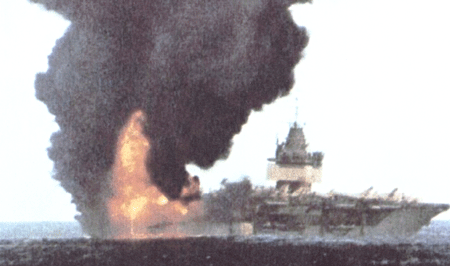
This web site is dedicated to those ships and sailors who were tragically lost in the pursuit of fighting for the freedoms we now enjoy.
Thanks for visiting this page! - Larry R. Matthews

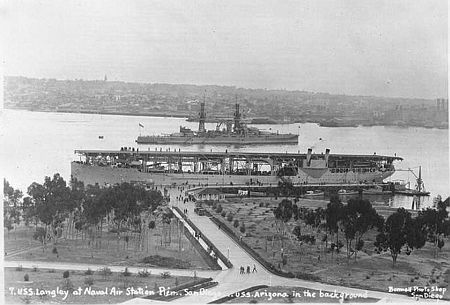
The USS LANGLEY with the USS ARIZONA behind her in San Diego in the 1920's.
USS LANGLEY (CV-1) - Sunk February 22, 1942. It seems almost fitting that the first U.S. Navy carrier was the first to be sunk in World War II. LANGLEY had originally been a collier but was converted to a carrier in March of 1922. She was the test carrier from which all U.S. Navy carriers came. She was sunk 75 miles off of Tjilapjap, Java. Three waves of Japanese aircraft attacked her. She was struck by 5 bomb hits, and took a 10 degree list. She was abandoned due to her desparate situation and she was sunk by U.S. destroyers that sent her to the bottom with guns and torpedoes. She was just one of the many victims of the Battle of the Java Sea. 16 of her men went to the bottom with her.
USS LEXINGTON (CV-2) - Sunk May 8, 1942. Torpedoed during the Battle of the Coral Sea. The great aircraft carrier seemed to stay steady after being struck by two torpedoes and two bombs. The crew managed to get the fires under control and all seemed to be well. Suddenly, a series of explosions ripped through the ship when the vapers of her fuel supply ignited. The ship was abandoned in late afternoon, and a destroyer finished her off with five torpedoes. Thus ended the career of one of the most remarkable aircraft carriers in the U.S. Navy.
USS YORKTOWN (CV-5) - Sunk June 8, 1942. Bombed and torpedoed during the Battle of Midway. On June 4, the Yorktown was bombarded twice by planes operating off of the Japanese aircraft carrier Hiryu. (the only surviving Japanese carrier of four, but it was also sunk that day) During the first attack she was struck by 5 bombs. During the second attack, however, two torpedoes found their mark, seriously damaging the carrier. The crew was evacuated by order of Captain Buckmaster but the carrier did not go down. She began to drift and a recovery team was able to board her on June 5, but she was not to be saved. The Yorktown was finished off on June 8 when struck by 3 of 4 torpedoes fired by the Japanese submarine I-168. The destroyer Hammann, moored to and providing power to the crippled carrier, was struck by the 4th torpedo and was lost with virtually all hands.
USS WASP (CV-7) - Sunk September 15, 1942. Torpedoed during the Battle of Guadalcanal. The carrier was hit by 2 torpedoes fired from a Japanese submarine. The fire spread quickly and got out of control. After little more than an hour she had to be abandoned. She continued to burn for 3 hours and was eventually sunk by U.S. destroyer Lansdowne.
USS HORNET (CV-8) - Sunk October 26, 1942. Torpedoed during the Battle of Santa Cruz in the Solomon Islands. She was struck by 2 torpedoes below the island. At almost the same moment a pilot of a crippled Aichi D3A "Val" bomber became one of the first Kamikazi's of the war when the pilot aimed his disabled plane into the island of the HORNET. In the afternoon the crew was taken off. Her fires were under control, but a strike from the carrier Junyo damaged her beyond repair. But the final "coup de grace" was administered later in the day by a Japanese destroyer who sank her with four "long-lance" torpedoes.
CVL:
USS PRINCETON (CVL-23) - Sunk October 23, 1944. Bombed during the Battle of Leyte Gulf near the Philippines. A highly skilled, lone Japanese pilot placed a bomb squarely between 6 armed torpedo bombers being readied for takeoff on the flight deck. PRINCETON crews fought to save the ship, but by mid-afternoon, fires reached the torpedo storage areas and the carrier had to be abandoned.
CVE's:
USS LISCOMB BAY (CVE-56) - Sunk November 24, 1943. Torpedoed off of the Gilbert Islands. At 5 A.M. two torpedoes struck almost simultaneously. At least one hit in or near the bomb stowage compartment and this meant that every bomb there exploded simultaneously. Men, planes and fragments of steel from the ship went high in the air. So high that the USS NEW MEXICO, which was traveling nearly a mile behind her, was showered with everything from plating to pieces of bodies and clothing. The whole after portion of the ship vanished. Immediately the ship was aflame from bow to stern, and one blast followed another as some bit of explosive or gasoline was found by the fires. All together 217 men were rescued. 591 enlisted men and 52 officers went down with the ship. Dorie Miller, the first black sailor to win the Navy Cross for his actions during the Pearl Harbor attack was killed aboard this ship. The culprit, Japanese submarine I-175, escaped.
USS BLOCK ISLAND (CVE-21) - Sunk May 29, 1944. Torpedoed off of the Canary Islands by a German Submarine.
USS GAMBIER BAY (CVE-73) - Sunk October 25, 1944. Sunk by naval gunfire off of the Philippines during the Battle of Leyte Gulf. A small band of "jeep carriers" came up against a much larger task force of Japanese ships. Leyte was hardly a carrier battle, but the stand of the "jeep carriers" off of Samar showed how much punishment the little ships could take. Their air groups were armed for softening up beach obstacles and strongpoints, not battleships and heavy cruisers, but their pilots made dummy runs at the Japanese ships. The Gambier Bay was sunk by numerous hits from shells. The pictures of this ship in this battle are quite spectacular.
USS ST LO (CVE-63) - Sunk October 25, 1944. Bombed during the Battle of Leyte Gulf off of Samar Island, Philippines. St. Lo was sunk the same day as the Gambier Bay when she blew up and sank after a Zero fighter set off her ammunition and aviation gasoline. A terrible day for the U.S. Navy.
USS OMMANEY BAY (CVE-79) - Sunk January 4, 1945. Sunk by a Kamikaze off of Mindoro, Philippines.
USS BISMARK SEA (CVE-95) - Sunk February 21, 1945. Struck by two Kamikazis off of Iwo Jima. The planes set off uncontrollable fires and exploding ammunition. Due to the great explosions the ship was abandoned and sank beneath the waves in 90 minutes with the loss of 318 men.

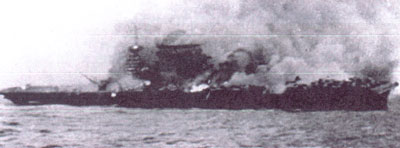

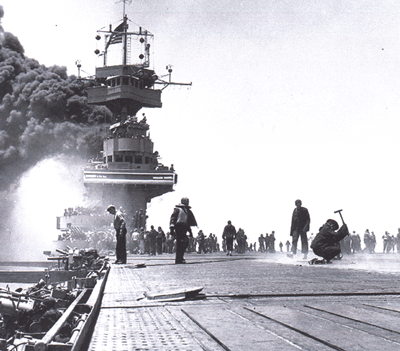

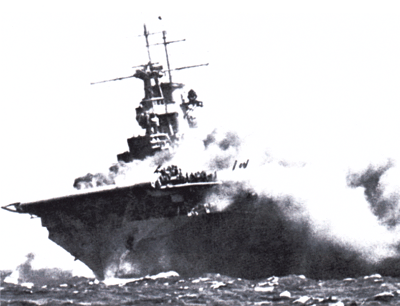

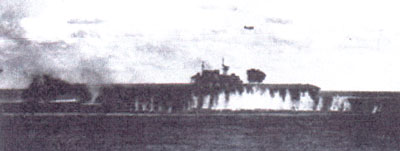

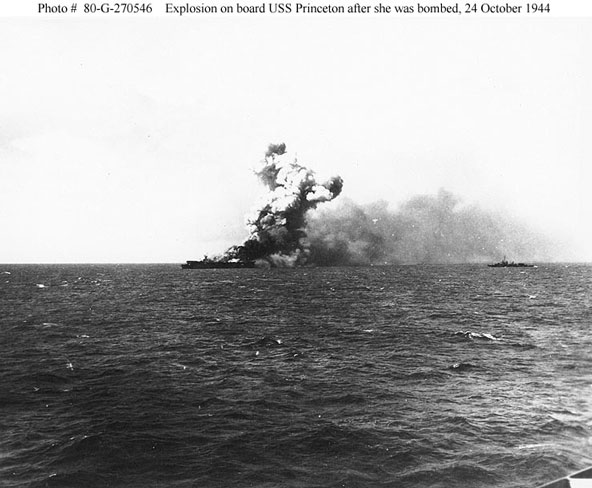

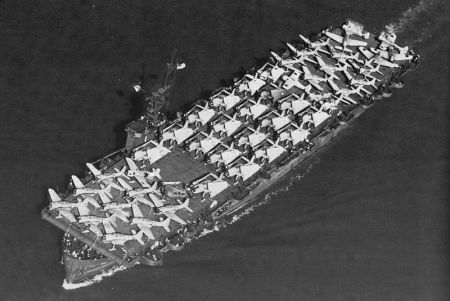

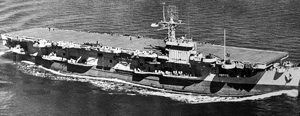



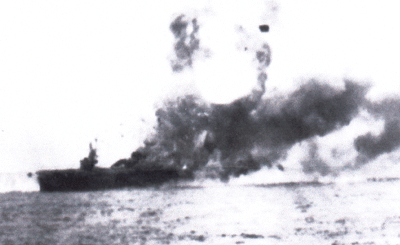

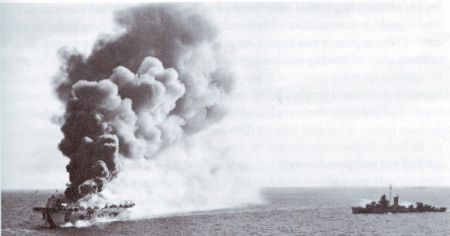

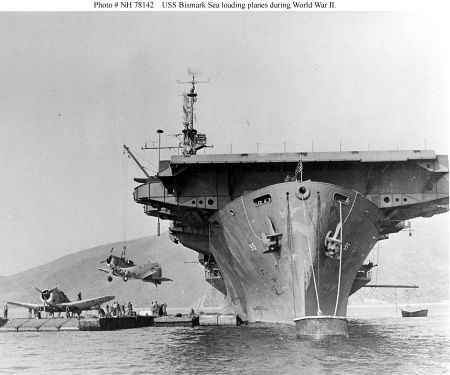

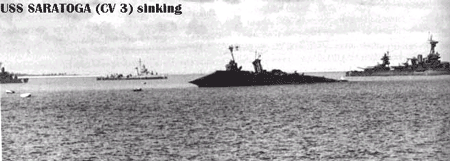
USS SARATOGA (CV-3) - The "Sara" was struck by 2 bombs and 5 Kamikazi's while supporting the Iwo Jima invasion on February 21, 1945. She lost 123 dead with approximately 300 injured. But this attack did not sink her. She survived the war but did not survive the atomic bomb tests off of Bikini Atoll. She went under after undergoing her second nuclear explosion on July 25, 1946. She was a tough old girl.

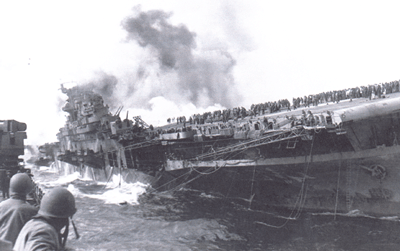
USS FRANKLIN (CV-13) - Known as "Big Ben". She was hit by Japanese bombs on March 19, 1945 and suffered horrendous losses. The bombs struck and the inferno was increased by the detonations of ready ammunition locker on the topside, filled with rockets and shells for the 5 inch, 40 mm, 20 mm and 50 calibre machine guns. Men died by the scores on the flight and hangar decks, or were trapped in the Combat Intelligence Center and the crowded deck workshops. The entire gallery, sandwiched between flight and hangar decks was a death trap. Offices and berthing compartments on the second and third decks were torn by explosions and swept by fire that spread from the hangar deck. Over 30 tons of high explosives were on the planes alone, and countless other tons in the lockers and ready magazines. But the FRANKLIN, charred, twisted and listing, somehow made it home, 12,000 miles through the Panama Canal to the Brooklyn Navy Yard. Her sailors fought the fires and she survived. But the ship never saw action again as the war ended before she could be repaired. 724 sailors died and 165 were wounded.

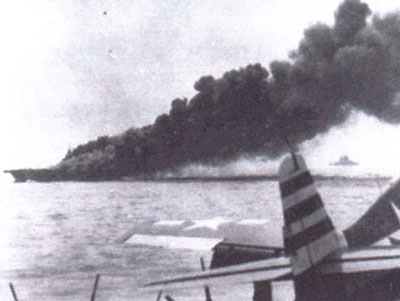
USS BUNKER HILL (CV-17) - The ship was stationed off of Okinawa on May 11, 1945. At 10:10 A.M. a Japanese Zero came in and dropped a 550 pound bomb and at the same time the plane plunged into the flight deck destroying 34 parked aircraft. Seconds later another Kamikazi dropped a bomb on the after flight deck. The blast blew sailors overboard and flames covered the flight deck. 375 sailors perished along with 264 wounded and 43 missing. The carrier was saved but was known as the "most severely damaged ship" ever to enter the Puget Sound Navy Yard.

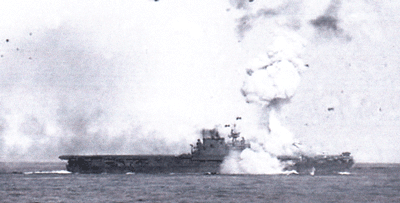
USS ENTERPRISE (CV-6) - The most decorated aircraft carrier of World War II was struck by a bomb-laiden Kamikaze off of Okinawa on May 14, 1945. The blast blew her forward elevator 700 feet into the air, killing 14 sailors and injuring 34.

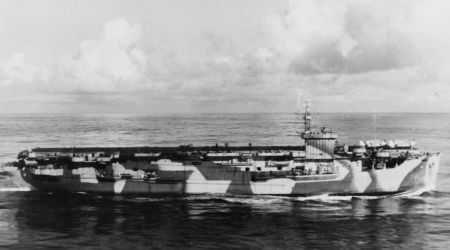
USS CARD (CVE-11) - The Card had been commissioned during World War II and had served in the Atlantic Fleet against German U-Boats. She was decommissioned after the war but recommissioned in 1958. She served in the Military Sea Transport Service transporting equipment to South Vietnam. On the night of May 2, 1964 the carrier was in the port of Saigon. Two Viet Cong commando divers climbed out of a sewer tunnel and attached two explosive charges to the hull. The attack sank the Card and killed 5 civilian crew. The carrier was refloated from its 48 foot deep grave and sent to the Philippines and Japan for repairs. She was decommissioned on March 20, 1970 and was scrapped in 1971.

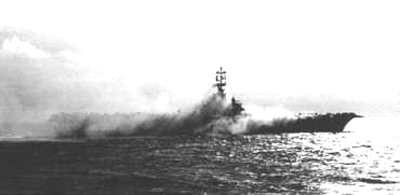
USS ORISKANY (CVA-34) - At 7:21 A.M. on October 26, 1966 magnesium parachute flares were mishandled by sailors transferring them into a flare locker on Hangar Bay 1 located on the starboard side. Instead of throwing the sizzling flare overboard (they were only a few feet from the edge of the deck) they instead threw the flare into the locker, thinking that the lack of air would extinguish the flare. However, magnesium flares do not require oxygen to burn. The seaman dogged the locker hatch down and sprinted for the telephone. The 575 flares in the locker began to explode in loud thuds, their magnesium heating the steel bulkheads of the locker to 7,000 degrees. With a terrible blast the steel hatch shot forth searing nearby sailors who ducked as rocketing fireballs passed over their heads. Smoke and flame poured into berthing quarters forward. Oxygen was sucked from compartments. Many sailors, mostly pilots sleeping from a night mission were trapped in their forward compartments and had to try to slip out of the small portholes to get fresh air. Some were towed from the porthole to the flight deck by ropes. Others were asphyxiated in their state rooms. The hanger bay was a mass of flames. The fire was extinguished in 3 hours and 7 minutes. A number of pilots were among those killed.
RMSN Jim Riley states that when the hatch blew, the fifty foot fireball rolled across the hangar bay setting fire to everything it touched and no one touched by it survived the initial blast. He indicated that helicopters melted, A-4 Skyhawks blew their ejection seats and wings melted from the Skyhawks. Jim provided me with copies of the New York Times and Atlanta Journal from October 1966 that verified that 44 sailors were killed. Fascianting articles! Jim stated,"I have seen some wild things in my life but I have never seen such heroics from (aveage of) 19 year old men and hope I never witness anything like this again. The unsung heroes of that day will never be surpassed by anyone in my lifetime."
Mario Gomez, AZ in Squadron VAW-11 Det Golf, was asleep when the fire broke out. When General Quarters was called he found his room full of smoke and could not see his hand in front of his face. He had to get low near the floor to see his way out of the room.
Mario said that Lt. John F. Francis, his boss, was the maintenance officer of the squadron. LTJG William R. Clements was the morale officer.
He said the fire was so hot that Lt. Francis' door was welded shut. "He was able to break it down but he never made it out. He was taken over by the smoke."
"LTJG Clements did get out OK but he went back into the fire to help his fellow officers. He came back with two officers in tow. Then he went back into the fire to help others in need but his time he did not come back out. He too, was overtaken by smoke."
Mario describes both officers with great affection. Both good, caring men who really cared about the sailors under their command.
My thanks to Jim and Mario for their personal accounts of this tragedy.
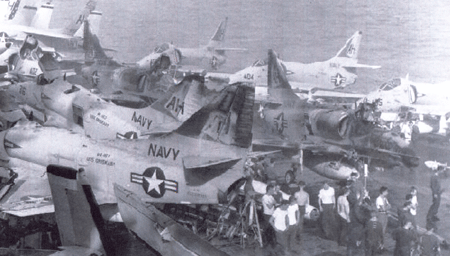

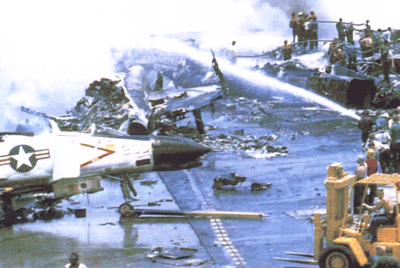
USS FORRESTAL (CVA-59) - At 10 A.M. on July 29, 1967 the carrier was on her first combat patrol of the war and preparing to launch her daily fighter strike on North Vietnam. Hundreds of the 4,300 man crew were moving about the four acre flight deck readying the planes. Suddenly, due to an electrical short, a rocket was fired from beneath a fighter's wing. It flew across the flight deck and struck the auxiliary gas tank of a Douglas A-4 Skyhawk as it was piloting up for takeoff.
The Skyhawk was piloted by John McCain (who became a POW a month later, a Senator from Arizona and a Presidential Candidate in 2000 and in 2007). The aviation fuel ignited and, within a few minutes caused the explosion of many 1,000 pound bombs, Zuni rockets and other ammunition. Fire fighting crews who began to fight the fuel fire disappeared in the blasts of bombs and rockets. Water hoses were holed by shrapnel. Whole firefighting crews were mowed down.
John McCain escaped just prior to the first bomb explosion by climbing onto the fueling probe on the nose of his plane and dropping to the flaming deck. Another pilot next to him ejected. Still another was never seen again. Crew members showed great bravery in unhooking the bombs from planes and unscrewing their fuses. Sailors carried 250 pound bombs and threw them over the side.
Four large craters were blown into the flight deck. 25 planes burned, more than what the North Vietnamese gunners brought down in an average month. Sister ships steamed to the Forrestal's aid. Carriers ORISKANY and BON HOMME RICHARD dispatched helicopters with doctors to remove casualties while destroyers HENRY W. TUCKER and RUPERTUS poured tons of water onto the carriers' flaming deck. Many sailors, driven to the edge of the flight deck and, rather than burn to death, hurtled themselves into the sea. These sailors accounted for many of the 134 fatalities. Flight deck video of this incident is like a vision of hell.

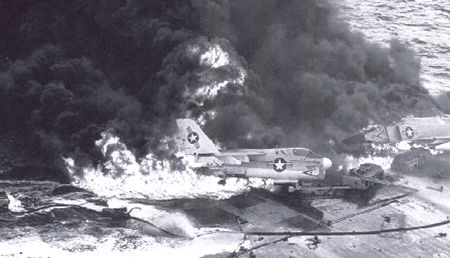
USS ENTERPRISE (CVAN-65) - On January 14, 1969 the nuclear powered ENTERPRISE lost 27 seamen who were killed by intense flames. Another 85 were injured.
The cause of the accident was an aircraft hander who left the tow bar in the wrong spot. So when the Huffer (a small jet turbine used to start the aircraft engines) was brought in to start the engines, it could not be placed correctly. The exhaust from the Huffer heated up a rocket warhead. Then it cooked it off.
The ENTERPRISE lost 50 yards of her flight deck due to the explosion of rockets, bombs and 20 millimeter ammunition. It took 40 minutes to bring the fire under control. (Another picture of this incident appears at the beginning of this web site.) The ENTERPRISE is the 8th American Ship to bear the ENTERPRISE name.


THIS IS A "LARRY" WEB SITE.
CHECK OUT MY OTHER QUALITY WEB SITES AT:
This page was last updated on January 29, 2015.
